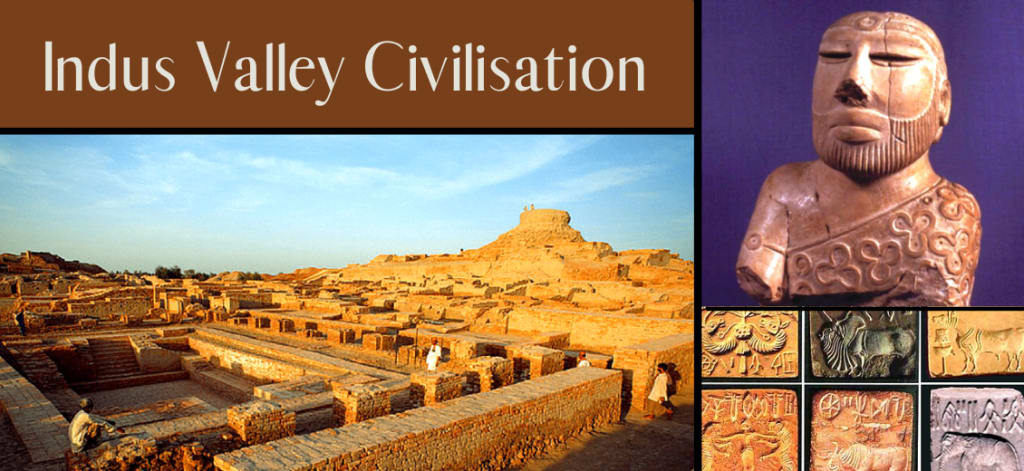Indus Valley Civilization
The Untold Mystery of Indus Valley Civilization

In 1827, a soldier of the British East India Company, James Lewis, was fed up with the antics of the company, and so decided to desert the army. To stay undercover, he changed his name and set out to follow his passion. Travelling. After travelling the Indian subcontinent for 2 years, he reached the Punjab region in 1829. Here he came across the ruins of an unknown, ancient city. He had no idea how old the ruins were. Or the civilisation they belonged to. Because he was very passionate about history, he starts documenting whatever he came across. He wrote notes and added drawings to them. The drawings on the screen were made by James Lewis. James Lewis was unaware that he had actually discovered the ancient city of Harappa.
100 years later, in the 1920s, some more information about this ancient civilisation was revealed to the world. John Marshall was appointed the director of ASI, and with the help of Indian archaeologists, he surveyed the ruins of Harappa. It was found that they were older than 5,000 years. Meanwhile, another historical site was found on the banks of the Indus river. The place contained many human skeletal remains. This place was named Mohenjo-Daro. The Mound of the Dead. Further excavations revealed more such ruins. Many such historical sites. It was found that buried in these ruins were the proof of a civilisation, that was unknown till then. Because these ruins were found on the bank of the Indus river, this civilisation was named the Indus Valley Civilisation. Today, in 2022, we know a lot of things about this civilisation. It is a part of the school curriculum as well. But two mysteries still remain. First, the Harappan language the one in which they wrote. What do these words mean? How can this writing be decoded? And second, the end of this great civilisation. What happened to these people? Come, in today's video, let's try to find out. "A city that remained buried underground for thousands of years, and now in archaeological excavations, one by one, these historical elements are being discovered." "The Indus Civilisation..." "...you try to understand, the Indus Valley Civilisation existed four thousand years ago." Friends, the Indus Valley Civilisation was a Bronze Age Civilisation, located in present-day Pakistan, Afghanistan, and Northwest India. In total, we have discovered more than 1,400 sites till now. Of which 900 lie in India. There are very few civilisations that existed along with Indus Valley Civilisation. There were hardly 3 or 4. Egyptian, Mesopotamian, and Chinese. Of these, the Chinese Civilisation was the most recent, so the Indus Valley, Egyptian, and Mesopotamian civilisations are considered to be the oldest. Evidence has been found that the farming settlements there were from 7,000 BC. It was discovered in the present-day state of Haryana. At the time, cities were developed, but there were agricultural tools, and some pottery.
The time during 7,000 BC to 5,500 BC, is known as the Pre-Harappan Phase. Archaeologists believe that the beginning of urbanisation was only after 5,500 BC. When public buildings and trade routes were set up. By 2,600 BC, their civilisation was so advanced, that multistoried brick houses were built in the city. The bricks they used to build, had standardised measurements. There were of the same size. Each house had a toilet. A bathing area, A drainage system to take water and waste out of the house, Proper gutters on the roads, The footpath had trees beside it. There were public wells for everyone to drink from. There were dustbins for people to throw waste in. In terms of Urban Planning, their cities were perhaps better than our Indian cities today. Even so, we cannot understand them better, because were do not understand their language. Look at these, more than 4,000 such artefacts have been found. Stone slabs, tablets, copper plates, all engraved with their language. Some in Harappa, some in Mohenjo-Daro, and some from other historical sites. The inscription on it is called the Indus Script. Ever since the 1920s, there have been more than 100 attempts to understand their language. But we still haven't figured out the meaning of these symbols.
Because there have been so many attempts to decipher it, and many samples of these inscriptions are available to us, some things can be said for sure. First, their language was written not from left to right like us, instead from right to left. When we write Hindi or English, we begin on the left margin, but languages such as Arabic, are written from right to left. The Indus script was also written from right to left. How do we know this? If you look at this image of the stone slab, the symbols on the left, look more cramped, you'd recall that in school, when you were writing and saw that there isn't sufficient space, you started cramming the words. The words would become smaller, and tightly crammed together. The same was seen on the inscriptions. The same thing happened to whoever was engraving this Indus Script, and this happened on the left side, So we can conclude that the language was written from right to left. Second, it was seen that the places where this writing was found, there would be some text at the top in Indus Script, and beneath it, a big symbol of an animal was engraved. This could be a rhinoceros, elephant, tiger, bull, but the most commonly found animal in the stone slabs, was a creature that looked like a unicorn. Which perhaps didn't even exist in reality. But the question is, what can be the reason that their writings were always followed by a picture of an animal? The third thing, these images may look like these engravings must be on big pieces of stones and rocks. But actually, these stone seals are about 2.5 cm² to 5 cm². So the engravings weren't on spacious pieces. Fourthly, the historians took the signs and symbols of the Indus Script, identified and collected them. It was found that there were 400 signs in their script. There are 26 alphabets in the English language. But their Indus Script had more than 400 signs.
Some symbols look like stick figures, you can spot some fish, turtles, crabs, insects, birds, But because the number of symbols in this script is so vast, historians believe that the Indus Script is actually a Logosyllabic Script. Logosyllabic means using symbols to express a word or a sound. Let me explain this with an example. The Egyptian hieroglyphs, the Egyptian symbols you must have seen, are from Egyptian Civilisation. Interestingly, friends, historians have decoded this language. Unlike the Indus Script, historians now know the meaning of each symbol used in Egyptian script. In this language too, each symbol represents a sound. For example, this symbol of the vulture, represents the sound '/aa'. This symbol of the leg, represents the sound /b. Similarly, you can see the translation of each sound, With the help of this chart, you can write your name in hieroglyphs as well. If I have to write my name Dhruv, it would look like this in Egyptian hieroglyphs. A hand for D, then a wick, and so on. Isn't it very interesting? Friends, we could decipher the Egyptian language because about 200 years ago, in an archaeological excavation, a large rock was unearthed.
A rock that contained some writing in Egyptian hieroglyphs. Beneath it, on the rock, the same thing was written in ancient Greek. Since we already knew Greek, this rock worked akin to Google Translate then. An ancient Google Translate. A language that we knew, and a language that we didn't. We could learn through this. This stone was named the Rosetta Stone. Later on, archaeologists discovered several other scripts and stones, which contained two languages together. The problem is that for the Indus Script, no such tablet or Rosetta Stone has been found. Thus we do not have a base to compare it with another language and learn from. Even though you can't learn their language yet, you can definitely learn English, through Cambly. English is a language that would be useful for your daily activities, and would help you progress in your career. Friends, Cambly is the only app in India, on which you can take one-on-one private English classes, from native English speaker tutors. The tutors living in the US, Canada or the UK, can teach you through Cambly. It is especially useful if you can already read and write English, but you aren't very confident while speaking it. Because the best way to improve one's speaking skills, is to talk to and practice with the native speakers of the language. On Cambly, you can take courses for the IELTS exam and for job interviews. The tutors on here are very friendly and supportive. Because this video was sponsored by Cambly, there's a Try Before You Buy offer for you. You can take their exclusive trial class for 15 minutes, which normally costs ₹99. But if you use the coupon code 29DR, it would cost you ₹29 only. For this minuscule amount, you should definitely try it out for yourself. And now let's get back to the Indus Valley Civilisation, friends. It is very difficult to imagine the meaning of these words and symbols. Think about it. If I give you Chinese literature, and you have no access to Chinese translation, you don't even know a language like Chinese exists, and I tell you to translate the Chinese symbols, Will you be able to translate them? It is next to impossible. Even so, the historians have discovered some patterns in the Indus language. If I ask you to list a word in English that begins with a W, You may choose Weather, Wire, Water, Watermelon, there are many words beginning with the alphabet W, But friends, if I ask you to list a word in English that begins with WZ, can you think of any? Or a word that begins with WQ? You can't think of any, because no such word exists in the English language. Because there's a pattern in every language. There are 26 alphabets in the English language, they are used in certain combinations that form a pattern. It means that you will find a lot of words beginning with WI or WA, But you won't find any beginning with WZ or WQ. Similarly in the Indus script as well, there are certain symbols that always follow others. Such as whenever this diamond-shaped symbol is used, it is followed by the symbol of two parallel lines. But it is never followed by this symbol of the stick figure. The most commonly used symbol is this jar-shaped symbol. And interestingly, this symbol is often seen and the end of the text in the Indus script. It is possible this is like a full stop or something signifying the end of the sentence.
The remarkable discovery was when the Indus script was found in Mesopotamia as well. The historical sites of Mesopotamia, like in present-day Iraq and Iran. We know that they had a different language, so if we found the Indus script written on stones over there, it means that first of all, there were trade relations between these two ancient civilisations. People moved between the cities. Secondly, we also know that these places had distinct languages because different scripts have been discovered. But the third and most interesting thing is that the Indus script found in Mesopotamia, the pattern we had seen in the Indus script, where this jar-shaped symbol is at the end of the text, in the script found in Mesopotamia is was found that the jar-shaped symbol is repeated twice. In the Indus Valley sites, this symbol hasn't been repeated ever. What is this mystery? What can be the reason for this? Historians claim that the reason for this is that the people living in Mesopotamia, were using the Indus script to write their language. If this seems a bit confusing, let's understand this with another example. We write Hindi in the Devnagri script. The script with क ख ग घ. And we write English in the Latin script. With A B C D. German, French, and such other languages are written in Latin script as well. German and French languages use A B C D too! So the speech, the way the language is spoken is not the same as the script in which the language is written. There is often a pairing between the two, but can you imagine writing Hindi in Latin script? You don't have to imagine this, because nowadays, everyone does this. क्या कर रहे हो? [What are you doing?] If we write this Hindi phrase in English's Latin Script, We will spell क्या as KYA, doing this means that we are writing Hindi in Latin script. But the language is still Hindi.
Historians believe that the Mesopotamians did the same thing. With the Indus script. They wrote their language in the Indus script. That's why there were certain patterns over there, that were not found in the Indus Valley. If you write the Hindi phrase आराम कर रहा हूँ [I am resting] in Latin, you will write the word आराम as AARAM, with two As at the beginning. You have used double A at the beginning, but this doesn't happen in English. No word in English begins with a double A, So you can see how it is evident that we have changed the pattern of the script. Moving on from the language, if you talk about the cities of the Indus Valley Civilisation, there is an interesting pattern there as well. In all the cities of the Indus Valley Civilisation unearthed till now, there is a similar pattern in all of them. There are two major segments in each city, First, the Lower Mount is surrounded by a boundary wall from all sides. And the second is a citadel in the area that is built on higher ground known as the Upper Mount. This citadel or fort was usually on the west of each city. It had its own boundary walls, And the Lower Mount had its own. This fort had all the important public spaces in the city, such as the marketplace, workshops, people used to meet others at this place, And the layer of the walls, the purpose behind building the walls was to keep the wild animals out. And to protect the cities from floods. So that even if the water in the river rises, it doesn't flood the city. Because back then, humans weren't a major threat. There weren't many humans back then. It is believed that there were no natural enemies of the civilisations.
So the chances are, there were no invasions from outside. The film Mohenjo-Daro tried to describe the structure of the city in detail. The film starred Hrithik Roshan, I think the city depicted in the film was close to being historically accurate. The most iconic attraction in the city of Mohenjo-Daro, is the Great Bath. It was a huge swimming pool. It was a multistoried bath, with the length of 900 ft² and depth of 2.4 meters, it was built with burnt bricks, and was waterproofed with natural tar. There was a drainage hole and a well too. It shows that there was fresh water in this swimming pool always. Since the level of cleanliness was quite high even in other cities, along with the drainage systems, it is believed that Mohenjo-Daro was perhaps the capital city of the Indus Valley Civilisation. A major difference from the Mesopotamia and Egyptian civilisations is that no temples, mosques, or religious sites have been found in Indus Valley Civilisation yet. No palaces or royal tombs. This means that we have not found any evidence that there was a monarch in the civilisation, or any priest or religious leaders, no evidence of any army or warfare either. It was quite shocking for the historians as well. Because in the other bronze age civilisations, Religion was very common.
It seems like the people of the Harappan Civilisation were very advanced. They lived happily, peacefully, and without any social hierarchy. This is a highly debated topic, and several historians disagree with each other. And now let's see another big unsolved mystery. How did the Indus Valley Civilisation end? Archaeological records show us that between 1900 BC and 1300 BC, there was a rapid decline in this civilisation. After this time, the planning of the cities stopped. The sewers and drainage systems on the road weren't maintained. The Great Bath was filled with waste, trade links with Mesopotamia had ended. By 1800 BC, most of the cities were empty. Neither were people using the same writing system, nor the standardised weights and building ratios. No one knows what actually happened here. There are some theories though. One theory suggests that the river on which this civilisation depended, started drying up.
This might have been the Saraswati River. According to this theory, there can be several reasons as to why this river dried up. There might have been a shift in the tectonic plates, or the river might have naturally changed its course with time, if this theory is correct, it is assumed that the people of the Indus Valley Civilisation, went Eastwards and settled near the Ganga River. The second theory suggests deforestation. That suggests that the people of the civilisation chopped down so much of the forest, to make their bricks and to feed their cattle, that it killed all greenery in the area making it uninhabitable. The third theory suggests that there might have been a fatal disease which wiped out the entire population. Such as malaria or cholera. Such things were actually quite common. As I had told you in the video on Red Plague, When the Red Plague was rampant, within thousands of years, it wiped out many civilisations. There are many diseases that can wipe out 70%-80% of the population. I will put the link to the video in the description below, you can watch it after this. Whatever the reason was, one thing that we know for sure now, after 600 BC, this civilisation was completely over. A civilisation that existed for thousands of years, literally, think about it, this civilisation existed for at least 5,000 years, our civilisation hasn't existed for even half the time, despite existing for 5,000 years, it met an ill-fated end. And we lost these unique people forever. With time, these settlements were buried underground. New cities were established over them. New civilisations were born on them. And so thousands of years later, James Lewis rediscovered this Indus Valley Civilisation.






Comments
There are no comments for this story
Be the first to respond and start the conversation.